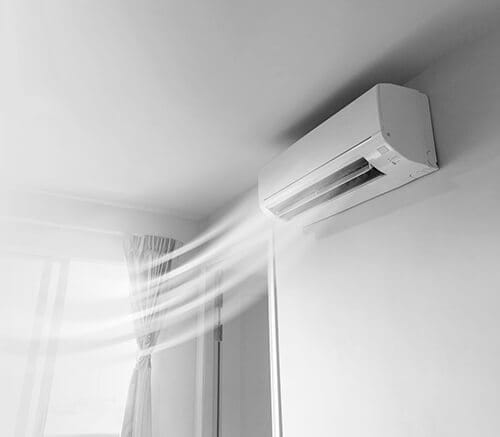
Many homeowners are increasingly opting for a ductless mini-split system. It offers more convenience and energy savings and requires less maintenance than conventional HVAC units. Here is an outline of how the ductless mini-split system works and why you may want to install it in your home.
How Ductless Mini-Split Systems Work
A ductless mini-split system draws air from the interior to the outdoor compressor unit. Through a series of tubing, the air is moved to the condenser unit, which contains a refrigerant. The air circulates through the refrigerant until it loses heat.
The air from the condenser is then sent back into the interior. After several cycles, the temperature of the room starts to fall to the desired level.
A ductless mini-split system will have multiple indoor units, typically two to four in number. Each of these units can be installed in different rooms to regulate temperatures independently. This feature gives the mini-split system a lot of flexibility and has many advantages.
Mini-split systems have a much smaller footprint than conventional central heating systems. The tubing from the condenser is a thin pipe that is usually three inches thick. The small footprint makes the mini-split system an ideal option for offices, apartments and extra rooms in your home.
Types of Ductless Mini-Split Systems: By Installation Type
There are different types of ductless mini-split systems. Single-zone configurations have only one condenser unit to one air handler and are meant for a single room. Most systems used today are multi-zone, having between two and four indoor units.
The compact design of ductless mini-split systems makes placement and installation much easier and more cost-effective. Mini-split air conditioning systems can also be categorized according to how they are mounted. Wall-mounted units are the most popular because of their affordability and convenience.
Other options include floor-mounted systems, which are ideal for interiors with large windows. The unit is installed at the bottom or close to the top of the wall. If you don’t want the space on the wall for the air handler, consider a ceiling cassette system that is placed on the ceiling of the room.
Types of Ductless Mini-split Systems: By Compressor Type
You can also categorize a ductless mini-split system according to the compressor type. The compressor contains the refrigerant, which transfers heat to and from the interior. It may have one or more motors to ensure consistent airflow through the coolant tubes. There are two main categories of compressors: inverter and rotary type.
An inverter compressor operates at variable speeds, depending on the temperature regulation demands. It draws power depending on the needs of the room. Its motors activate when heating or cooling is desired. The advantage of this technology is that it consumes power only when necessary.
Modern models of AC equipment may have dual motors to stabilize the function of the compressor. It ensures that the equipment is operating at high levels of precision to conserve power. You can talk to Gallagher's Plumbing, Heating and Air Conditioning in Sacramento when you need an efficient AC for your home.
On the other hand, there are ductless systems that still use the rotary mechanism. The rotary technology will prompt the motors to run at any time the system is on. Because they are less efficient than inverters, they are hardly present in the most recent models of AC equipment.
Features of Ductless Mini-Split Systems
A ductless mini-split AC can have additional features that make its operation more convenient. The features will vary depending on the brand and model of the equipment.
Convenient features of a mini-split system may include:
- Automatic restart
- Adjustable airflow
- Programmable thermostat
- Washable air filter
An automatic restart will start the system every time it turns off due to a power failure. This feature prevents damage to the compressor and the circuit breaker.
Some models may allow you to adjust its louvers via remote control to manage airflow. Other systems require manual manipulation to control airflow into the room.
A programmable thermostat makes it convenient to control the air conditioning unit remotely. You can set your system to heat the interior right before you get home. That way, you don’t have to keep it running all day for you to find warm temperatures when you return.
Energy Efficiency of Ductless Mini-split Systems
The ductless mini-split system is one of the most efficient for regulating indoor temperatures. The energy efficiency of a ductless air conditioner is usually measured by SEER (Seasonal Energy Efficiency Rating). In the United States, the minimum SEER rating is 13, and the highest figure a unit can have is 21.
If your ductless mini-split system has high energy efficiency, it can receive an Energy Star Rating. The rating is for HVAC products that demonstrate exceptional performance and cost savings for consumers. You can cut down energy consumption in your home by up to 30%.
The cooling capacity of an HVAC system is measured using BTUs (British Thermal Units). Each of the indoor units can work independently. Therefore, the BTU of each air handler must match the demands of that room. The square footage of the room will determine the right sizing for your system.
Keep in mind that the evaluation of your home cooling needs will depend on other factors besides square footage. Your climate is one of the variables you should factor into the calculation. Trees and other features around the building will also determine your needs. One of our technicians at Gallagher's Plumbing, Heating and Air Conditioning can do a thorough assessment before a new installation.
Zoning With Mini-Split Systems
Since ductless mini-split ACs have multiple air handlers, they can be useful for creating zones. You can have one indoor unit in the garage, one in the living room and another on the first floor. That way, you can maintain temperatures in places with varying cooling demands.
Every indoor unit connects to one indoor unit through refrigerant lines. Each unit can be controlled independently and will often have a thermostat. The thermostat is in the room to be conditioned, and it determines the amount of heat required by the indoor unit.
Zoning with mini-split systems can have significant energy savings for your home. An outdoor unit utilizes a heat pump to provide cool air to the respective indoor units. A heat pump is more efficient at both dispensing and generating heat for regulating interior temperatures.
When to Choose Ductless Mini-Split Systems
A ductless system has a compact design that takes a relatively small amount of space. Because it does not have ducts, it is not plagued by the same leak and airflow issues common in conventional heating. For that reason, it is suitable for places where ductwork would be impractical. It can be installed in offices, apartment buildings, and small spaces.
A ductless mini-split is particularly suitable for a bedroom addition. It is a more affordable option than extending your ductwork. The sleek and compact design of a mini-split system has aesthetics that can complement modern interiors.
Gallagher's Plumbing, Heating and Air Conditioning has experienced professionals that can assess your home’s heating and cooling needs. Our NATE-certified team has the requisite skill to troubleshoot or install a ductless mini-split system. They can also help you address your indoor air quality concerns.
For reliable heating and cooling services in Sacramento, don’t hesitate to contact our BBB-accredited team today.

